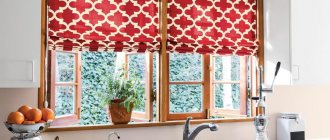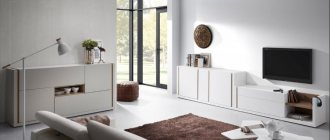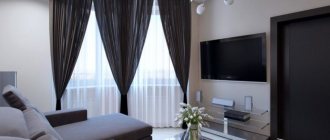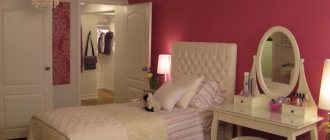Choosing the right wall color
In most cases, hallways are small. Basically, these are square or elongated rooms. The small area limits the choice, but there are criteria that should be taken into account:
- Area and layout of the premises. The smaller the hallway, the brighter the interior should be. A large corridor in a private house can be decorated in shades of dark colors, but for a small room it is worth choosing lighter shades.
- A stylistic direction that is used for interior design. Each style has characteristic features that you need to use to create a beautiful and stylish hallway.
- Features of the layout. In order to visually reduce a long corridor or increase the height of the ceilings, you should choose wallpaper with vertical stripes. To lengthen the room, a horizontal strip on the walls is suitable.
- Lighting affects the overall perception of the interior. Many corridors lack windows; the lack of natural light can be compensated for by placing artificial light sources. Good light will help highlight the color of the walls.
- It is not recommended to use more than 3 shades to decorate a hallway.
When choosing materials, it is worth considering the load on this functional area. Every day residents leave the house and return back. Depending on weather conditions, wet clothes, dirty shoes and wet umbrellas may appear in the hallway. Preference should be given to materials that are resistant to dirt and moisture. It would be appropriate to replace the snow-white shade of the walls with beige or cream.
Interior and lighting of the hallway Source Fashionable kitchen
Advantages and disadvantages - what more?
Performance characteristics make the tile an undoubted leader in terms of:
- Strength. Tiles intended for floors can withstand heavy loads and mechanical stress.
- Endurance. The material is resistant to detergents and other aggressive materials.
- Hygienic. It does not form mold or mildew.
- Moisture resistance. This figure is very high. Floor tiles are not afraid of humidity, water, even in moments of flooding.
- Durability. High-quality material, properly laid, will last an average of 50 years without losing its presentation.
- Decorative. The world of floor tiles is wide. This means that the possibility of choosing colors and textures is very large, which allows you to create different floor designs in hallways.
- Hygienic. The materials are made from natural components, which means they do not pose a risk to human health.
- Fire resistance. The tile does not burn, does not melt, and does not spread fire.
- Appearance. Floors finished with tiles will always look beautiful, and the interior of the corridor will be complete.
- Ease of repair. If one of the plates is damaged, it can be simply, quickly and easily replaced with a whole one.
Wear-resistant material
Flaws:
- Tile is a cold and quite hard material. It is uncomfortable to walk on it barefoot. The situation can be corrected by installing heated floors. If space allows, you can tile one part of the room, and the other with some other covering.
- Slip. Glossy tiles have a high slip coefficient. Therefore, it is better to buy a matte one for the corridor. It is a little rough on the front side, and therefore has a lower slip coefficient.
- Tiles with grooves and bumps quickly get dirty and collect dust, especially near the front door. Therefore, it is better to put a dark one here; the main area can be made light.
Universal colors, their features
The hallway connects the apartment or house with the outside world. Only the necessary furniture intended for storing clothes is placed in a small area. You can decorate the room by decorating the walls and using a small number of decorative elements.
As the main color, you should choose universal shades that look harmonious in any interior; you can easily match them with bright decor. The main color should occupy about 70% of the entire interior, the number of bright spots should not exceed 30%.
Universal shades that are perfect for hallway design include:
- light yellow;
- beige;
- sand;
- terracotta;
- cream;
- peach;
- mint;
- grey;
- pearl gray;
- coffee with milk;
- lilac.
Light gray walls in the hallway Source artsten.ru
Gray tones in combination with beige, many mirror surfaces, and white accents allow you to create a stylish interior. Gloss and many mirrors visually increase the space. Depending on what effect you want to achieve, you should decide what color to paint the corridor.
Warm shade for wall decoration Source mebelvdome.org
Shades of bright colors enliven the interior and give it a mood. Painted mustard walls highlight the neutral beige doors and brown wardrobe. Despite the lack of lighting, the hallway is warm and cozy.
The optimal solution for decorating a hallway is natural shades chosen for the base, and bright spots that dilute the boring design. The living space, the design of which is made in a single color scheme, looks stylish and complete.
The color difference allows you to harmonize the interior, which also gives the interior a sense of dynamics. For this purpose, various combined colors or several shades of the same color are suitable.
Classic style - colors for walls
When you need to design an interior that will remain relevant for a long time, you should give preference to the classic style. This direction is characterized by rigor, elegance and functionality. Natural materials are ideal for finishing and decorating a room:
- Fine wood or stone tiles, such as marble, are suitable for the floor.
- They make stucco on the ceiling.
- It is better to choose plaster cornices.
- For walls, paint with a matte finish, wallpaper with ornaments, and decorative plaster are suitable.
Interior design of a bright hallway Source design-homes.ru
Designers advise painting the walls in the hallway:
- white;
- gray;
- beige;
- olive;
- burgundy;
- brown;
- purple.
The classic style welcomes light and muted colors. Plain wallpaper, Venetian plaster, and paint are suitable for wall decoration. The hallway should be painted in a single color scheme; the material may contain a light pattern or design.
Carvings, columns and stucco will help complement the monochromatic design. Also, as decoration you can use natural materials, mirrors, luxurious wall lamps, which will be combined with the main lighting fixtures in the corridor.
Classic corridor design Source prihozhaya.guru
In the presented version, the walls are painted with beige paint, and black and white tiles with squares were used to decorate the floor. Mirrored cabinet doors increase the space and, by reflecting the flow of light, create interesting shimmers. To decorate the hallway, we hung a luxurious chandelier and installed a decorative vase in the corner.
Light shades are better than others for decorating a hallway in a classic style. In combination with light furniture and decorative elements, the interior looks luxurious and majestic.
Shades of dark colors can be used for spacious hallways. It is important to provide good lighting that will highlight the chosen wall color or pattern.
Interior design of a narrow corridor Source yellowhome.ru
The walls of a traditional classic hallway are predominantly light and warm. All details are harmoniously combined with each other; there are many unusual and beautiful decorative elements in the room. Neoclassicism is characterized by a wider range of colors. Contrasting colors and bright details can be used.
Black and white floors in hallways or corridors
The hallway floors, designed in this way, make it clean and bright, but if it lacks functionality, it will look like a banal protest to a cliché that developed a long time ago. White floors provide a unique opportunity for owners to demonstrate their desire for cleanliness. This decision is very unusual - not everyone can take such a step.
This combination makes the hallway clean and bright.
Combination of black and white zones
The key point of this design is a successful combination if you need to narrow or expand the space of the room. Dark zones visually narrow and bring objects closer, while light zones make objects appear larger and further away. In small rooms there should be more light colors, in large ones you can try experimenting by adding more black areas.
The only way to use black to visually enlarge a corridor is to choose gloss.
Playing with light
To prevent the room from being annoying, it is recommended to make one of the tones the background (leading) and the second - an addition.
In the black and white version of the floor design you will have to try hard, putting in a lot of effort and patience. The white areas must become dominant and the lighting must be increased.
You also need to keep in mind the fact that on black all the sloppiness and dirt will be more visible than on white.
Furniture should be selected so that all items are closed. In open spaces or with glass, things and objects that are located in them will significantly spoil the harmony. Best buy:
- closet;
- dresser;
- special shoe lockers;
- bedside tables with drawers.
This is a very unusual solution.
Areas located near the entrance to the house are decorated in a dark color. To combine with tiles, durable and wear-resistant floor coverings are selected. The hallway is a room where cleaning is done much more often than other rooms, so the floor must be able to withstand cleaning agents well. The most suitable is laminate, although he is afraid of too aggressive chemicals.
Advice In rooms where cleaning will be done too often using strong detergents, the floor should be made only of tiles. It’s easy to combine different textures and colors with each other.
Mosaic slabs will also look interesting. You can add charm to the corridor if you use floor tiles that resemble natural stone.
Dark color is used for the area near the door
Each of the listed warrants is well presented in black and white. Here you can use various decorative methods: playing with patterns, drawings or a whole picture version.
Choosing a color for a narrow hallway
The main task of designing a narrow hallway is the correct placement of furniture and visual expansion of the space. Light color of the walls and ceiling will help to visually raise the ceiling. Enlarged doorways will add solemnity to a narrow hallway.
By using zoning for the entrance and lobby areas, you can create the correct proportions in the room. Different stylistic directions, light, color, floor and ceiling finishing will allow you to highlight functional areas.











